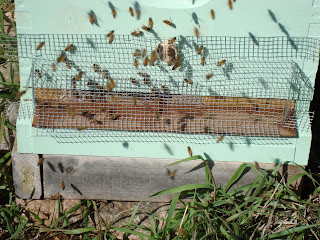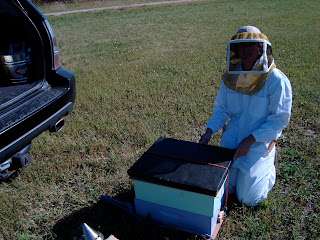
One day after being distressed at the view of the ongoing fights between the Italian and Carniolan bees over their golden liquid; Ben and I retrenched home to concoct a plan to reduce the pillage.
To slow down the enemies, some obstacles had to be in place. Therefore Ben built a "robbing screen" using a 1/8 metal mesh which he cut and bent in order to cover the whole and lonely entrance. This contraption will then force the honey bees to slow down and work harder to get their prized destination: Honey. After the Italians pass through the first obstacle, they will not be in yet! They will have to force their way via a 3" elongated gap covered with another 1/8 screen cloth where Carinolan honey bee guards will still be waiting for them, and ready to defend their hive.
In addition, during my copious reading about defending ones' hive; I fell upon an interesting tip given by a well known beekeeper named Michael Bush: "to reduce robbing by other bees, simply apply some Vick's Vaporub along the entrance". The strong odor of camphor, eucalyptus oil and menthol will confuse the robber bees which are guided by their sense of smell from their antennae to the source of honey. However the local Carniolans' dwellers are directed by their queen's pheromone and are not bothered at all.
I grabbed my jar of Vick's and with Ben having fashioned his apparatus; we headed back to Shakopee, more determined than a pack of mules! Ben installed his barrier and I smeared a good coat of the viscous concoction in front of the main entrance. We then stayed a little longer to observed. we could see that it was more difficult for the Italians to access the hive and they seemed to be repulsed by the powerful sent of the camphor mixture.
But would it be enough? Bees are smart. Will the Italian bees outwit the beekeepers? Only time will tell.
































